25 Common Backyard Birds in Nevada (With Pictures)
Last Updated on
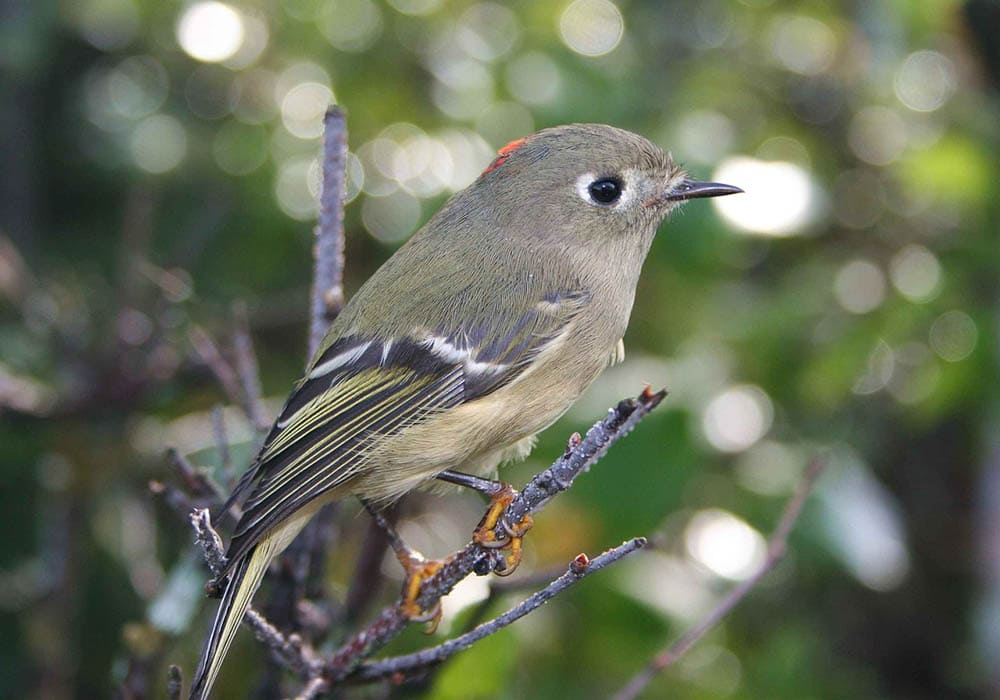
There is a lot of sparsely populated desert in Nevada. But that doesn’t stop the state from being home to many species of birds. Many live in the state year-round, but some are migratory and only spend one or two seasons there.
This article explores 25 common birds you can find in a Nevada backyard. Each listing will give you a brief overview of the species. So, you can read about them, pick your favorite, and go on a search for it. We’ll cover brown birds, red birds, and songbirds!

Top 7 Brown Birds in Nevada:
1. White-Crowned Sparrow

| Length: | 5.9–6.3 in |
| Weight: | 0.9–1 oz |
| Wingspan: | 8.3–9.4 |
A short bill and a long tail are two significant characteristics of the white-crowned sparrow. It also gets its name from its head’s black and white stripes. If you notice that the markings on its head are brown instead of black, that just means it’s a younger bird.
The rest of this tiny bird’s body is a mixture of gray and brown, with some black and white markings on its back and wings. It is quite common to find these birds in low, bushy areas on the ground or hopping around on branches at waist level.
2. American Robin
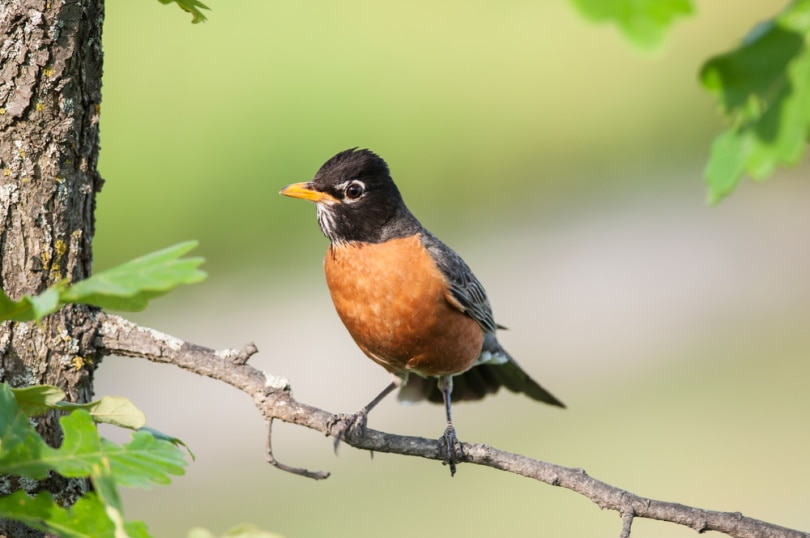
| Length: | 7.9–11 in |
| Weight: | 2.7–3 oz |
| Wingspan: | 12.2–15.8 in |
You’ll find that most American Robins are a mixture of gray and brown. They also have orange bellies and chests. You’ll also notice a large white spot under the tail that stands out in flight. One of the major differences between male and female robins is that the females tend to have paler heads compared to the males.
It’s really common to see these birds hopping around on the lawn. They will also stand and look around as if checking out their surroundings. During the fall and winter, American robins will gather in large flocks to roost and fill up on berries.
3. Mourning Dove

| Length: | 9.1–13.4 in |
| Weight: | 3.4–6 oz (Female: 3–5.5 oz) |
| Wingspan: | 17.7 in |
Mourning doves range in color from a soft brown to tan. They also usually have black-spotted wings with black borders on the white tail feathers. Quite often, these colors will match the surrounding area they are calling home.
Mourning doves can be found in several different environments. Fields and bare ground areas are common; the only place where it is unlikely you will find a mourning dove is deep in the woods.
4. House Sparrow

| Length: | 5.9–6.7 in |
| Weight: | 0.9–1.1 oz |
| Wingspan: | 7.5–9.8 in |
The house sparrow is another small sparrow on the list. Even though these birds share some similarities to the North American sparrow, they are unrelated. Male house sparrows are a little more colorful than the females, with a mixture of gray, white, and black. But females are typically a little more brown overall.
House sparrows live with humans and have done so for many years. It’s common to see them in parks or zoos looking for an easy snack. They are even common to see in the middle of the city. Interestingly enough, the house sparrow doesn’t actually like being in areas of undisturbed nature. Almost as if they prefer to be around humans.
5. Great-Tailed Grackle

| Length: | 15–18.1 in |
| Weight: | 3.7–6.7 oz |
| Wingspan: | 18.9–22.8 |
The great-tailed grackle is a reasonably large blackbird, almost the size of a crow. The male birds are iridescent black all over with the most intense yellow eyes. They also have a large tail that folds into a distinct V-shape.
We’ve included this bird under the brown bird heading because of the female grackle. They are a similar size to the males, but they are brown overall with a buff-colored patch on their throat and stripe above the eye.
These birds appreciate developed areas like the house sparrow. So, you’ll often find them in agricultural fields, backyards, parks, etc.
6. Dark-Eyed Junco
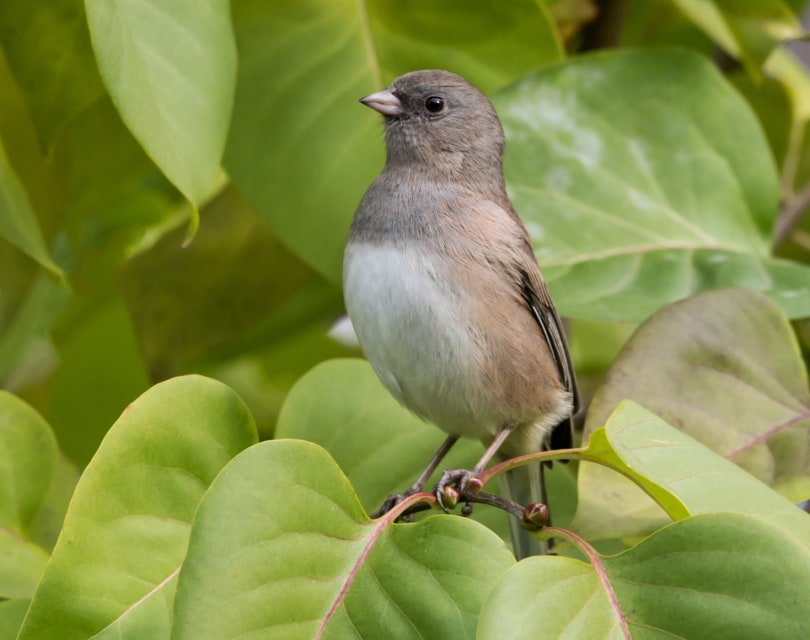
| Length: | 5.5–6.3 in |
| Weight: | 0.6–1.1 oz |
| Wingspan: | 7.1–9.8 in |
The dark-eyed junco is not specifically a brown-colored bird because their coloration varies quite wildly from slate gray to mostly white, depending on their area. However, the most common colors are dark brown to gray with white tail feathers and a pink beak.
These birds can fly but prefer to spend most of their time hopping around on the ground. You’ll hear them chirping away as they forage for a snack around the base of trees and brush, almost as if they are singing or talking to themselves as they look around.
7. Bewick’s Wren
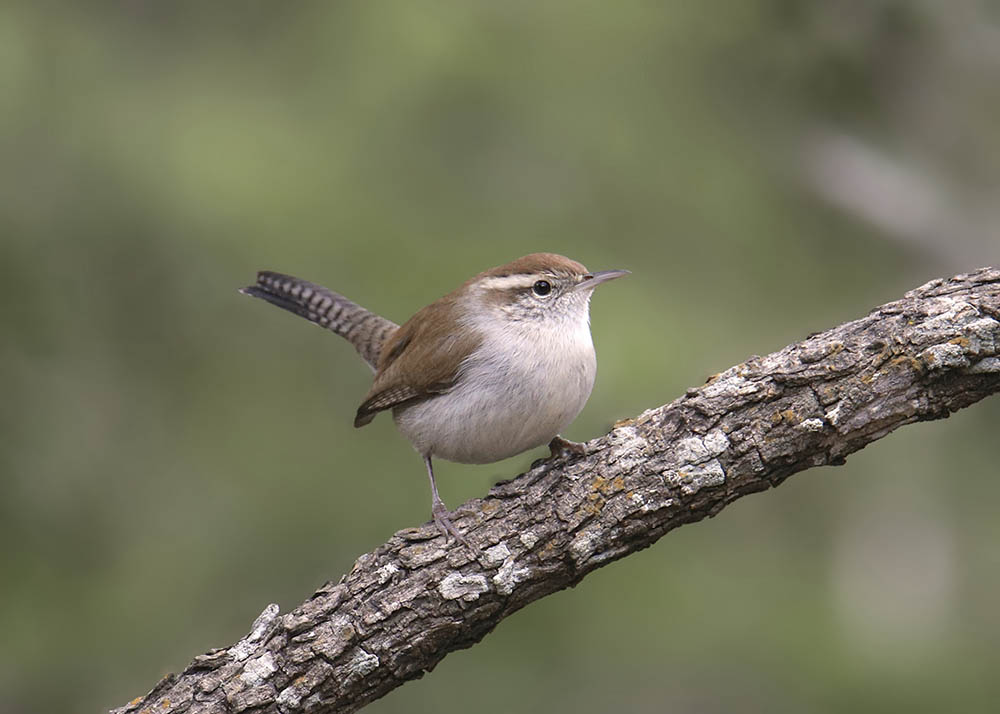
| Length: | 5.1 in |
| Weight: | 0.3–0.4 oz |
| Wingspan: | 7 in |
These little wrens typically have light gray to white chests and throats, and their backs are usually brown. Their long tails are also brown but darken to black with white spots at the tip. There are no significant differences in color or pattern between the males and females.
A neat characteristic of Bewick’s wren is their tail movement. They often flick it back and forth and fan it out as they hop through branches and leaves in search of a bug to snack on. You’ll know it’s mating season for these little birds when you hear the males singing at the top of their lungs from tall branches.
Top 7 Red Birds in Nevada:
8. Red-Breasted Nuthatch
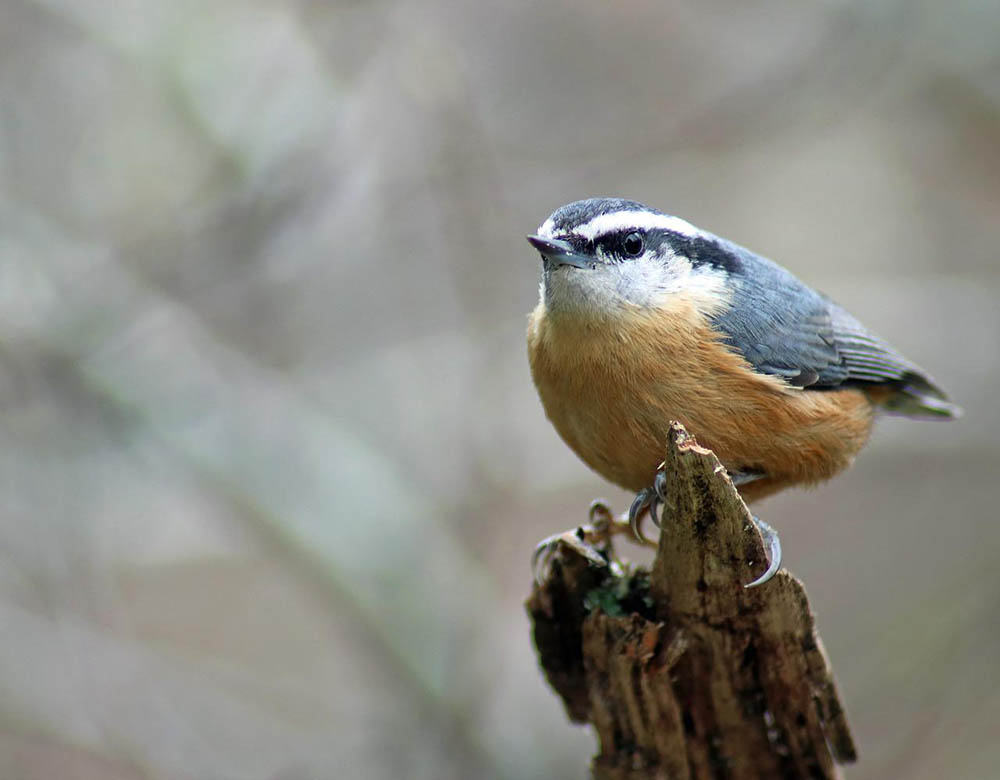
| Length: | 4.3 in |
| Weight: | 0.3–0.5 oz |
| Wingspan: | 7.1–7.9 in |
The red-breasted nuthatch gets its name from the rich cinnamon color of its underparts. Males and females have the same feature, but it’s often paler in females. Other than their red bellies, these birds typically have a blue-gray coloration overall with black and white stripes on their heads.
One standout characteristic of the red-breasted nuthatch is its long, pointed beak. They make good use of it by poking it into crevices in trees in search of food. They are nimble and creep along a tree up, down, sideways, and upside down.
9. House Finch
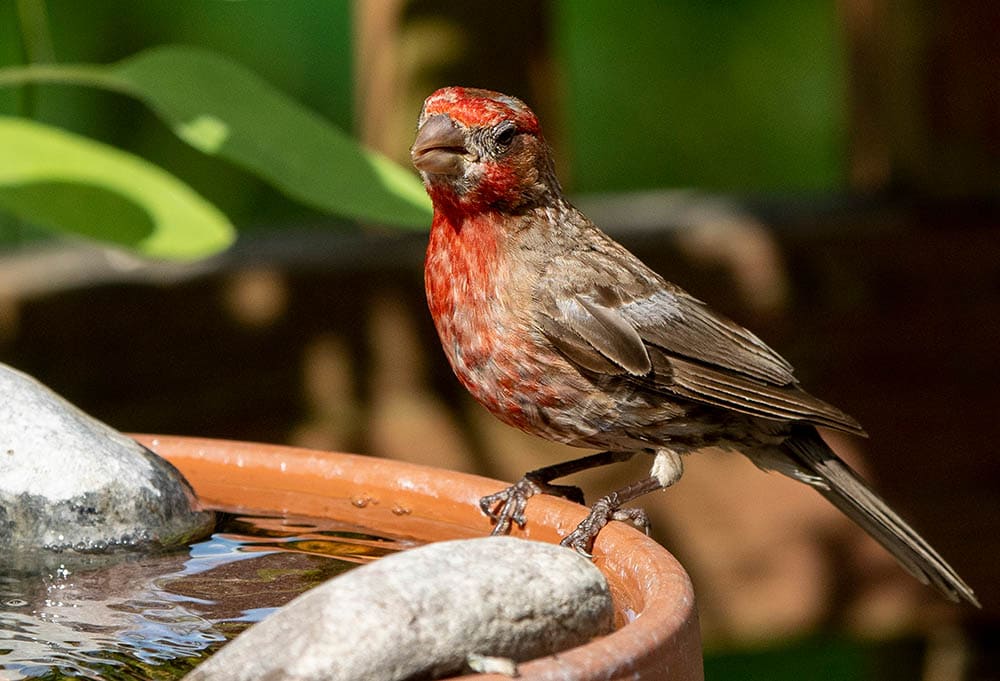
| Length: | 5.1–5.5 in |
| Weight: | 0.6–0.9 oz |
| Wingspan: | 7.9–9.8 in |
An adult female house finch is a plain, pale brown. The males are what land these birds a spot under the red birds in Nevada heading. Male house finches also have brown and gray colors down their back and tail, but they have a bright red upper chest and face.
House finches love being in developed areas like yards, parks, or farmland. However, you’ll also find them in their natural habitats like deserts, grassland, or forested areas and open woodlots.
10. Summer Tanager
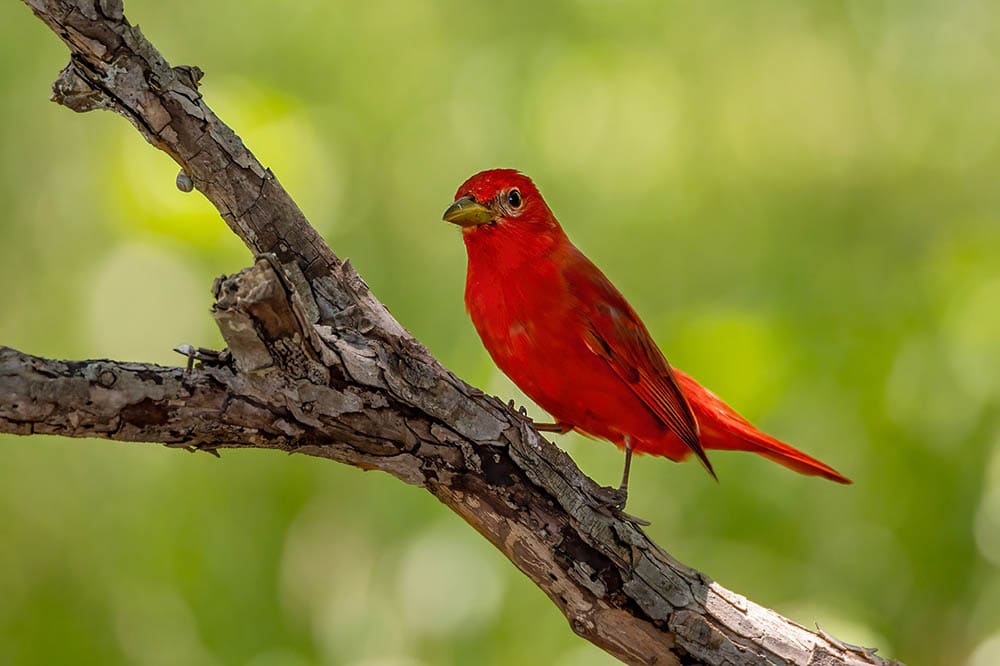
| Length: | 6.7 in |
| Weight: | 1.1 oz |
| Wingspan: | 11–11.8 in |
Young males and female summer tanagers are bright yellow-green. Typically more on the yellow side on their heads, but progressively more green towards their tail and wings. However, we put them under this heading because the males undergo an incredible transformation and become bright red as adults.
You’ll see these birds high in the treetop canopy catching unlikely insects flying through the air. The males sing a pleasing song that resembles that of the American robin.
11. Red Crossbill

| Length: | 5.5–7.5 in |
| Weight: | 1.4 oz |
| Wingspan: | 10–11 in |
Similar to the summer tanager, the red crossbill is also significantly different in color between males and females. The females are mostly yellow and brown, but the males are a brick red overall which darkens on their wings and tails.
These birds prefer areas that have coniferous trees as the seeds are one of their primary sources of food. Another interesting fact about these birds is that they will often forage for food in large flocks and typically fly from tree to tree simultaneously.
12. Common Redpoll

| Length: | 4.7–5.5 in |
| Weight: | 0.4–0.7 oz |
| Wingspan: | 7.5–8.7 in |
The common redpoll is a mostly brown and white bird with streaked sides and wings. However, they also have bright red forehead patches with black around their eyes and beak. The males also have a red patch covering their upper flanks and chest.
One crazy thing about these birds is that they often flock in groups of up to 100 or more birds. Sometimes, they never seem to stop moving. They’ll be busy foraging one second, and then as a group, they take off and start swirling around the next.
13. White-Winged Crossbill

| Length: | 5.9–6.7 in |
| Weight: | 0.8–0.9 oz |
| Wingspan: | 10.2–11 in |
Females and immature males have a yellowish-brown coloration with black wings and white wing bars. However, the adult males are a rosy pink color with those same wings. Both males and females have a slightly forked tail and hooked bill.
These birds spend their time in large flocks in spruce and tamarack forests. However, they are also known to frequent backyard feeders if their favorite seeds are provided.
14. Red-Breasted Sapsucker
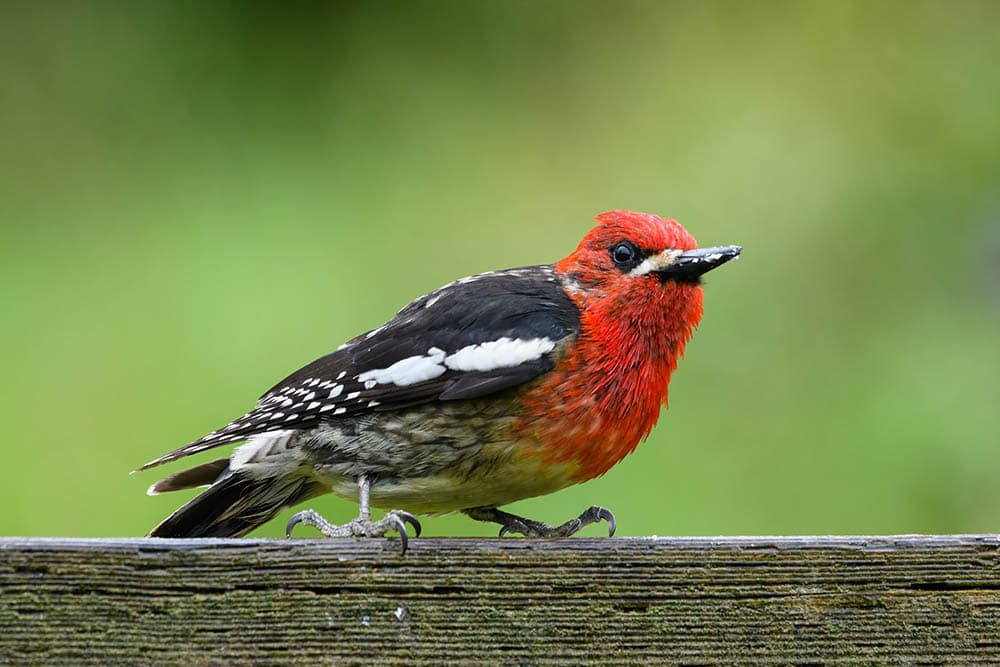
| Length: | 7.9–8.7 in |
| Weight: | 1.9–2.2 oz |
| Wingspan: | 14.6–16 in |
The red-breasted sapsucker is an intriguing woodpecker species that drills lines of small holes in a tree’s bark. Then they drink the sap and whatever bugs are unlucky enough to become the bird’s next meal.
Their most characteristic feature is the bright red heads and breasts of the females and males. The rest of their bodies are a mixture of black and white. Mostly black with white spots on the back and then primarily white and gray on their underparts.
Top 11 Nevada Songbirds:
15. Ruby-Crowned Kinglet

| Length: | 3.5–4.3 in |
| Weight: | 0.2–0.3 oz |
| Wingspan: | 6.3–7.1 in |
The ruby-crowned kinglet is mostly an olive-green color with obvious white markings around its eyes and white and black contrasting wing bars. Their name comes from the red crown that the male sometimes puffs up. But the red isn’t really visible unless the bird puffs it up.
These birds like to be moving all the time. Typically they will stay reasonably close to the ground, looking for food. Dense forests are a favorite place for the ruby-crowned kinglet. However, you can also find them in developed areas like parks, shrubby habitats, and wooded backyards.
16. Northern Mockingbird
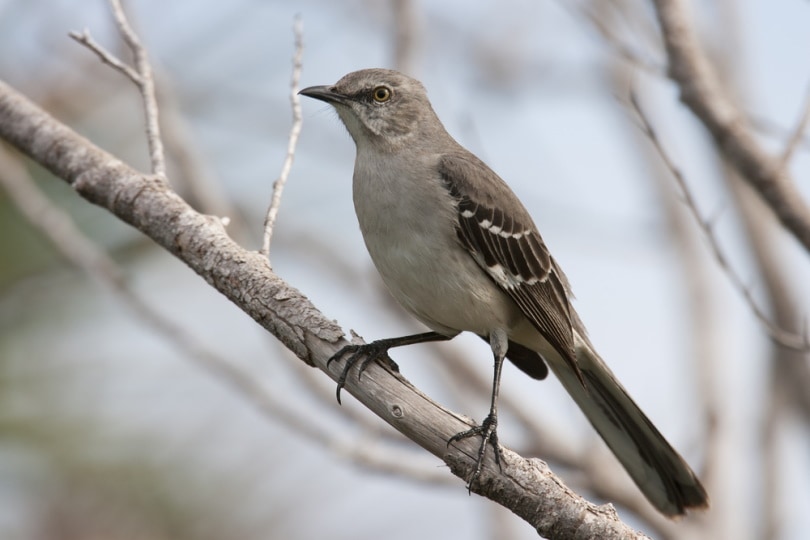
| Length: | 8.3–10.2 in |
| Weight: | 1.6–2 oz |
| Wingspan: | 12.2–13.8 in |
The coloration of the northern mockingbird is gray-brown overall. Typically their colors are paler on the chest and belly, and they have patches of white on their wings. While they fly, you’ll notice the patches on their wings get bigger and more obvious, and a white patch on their tail also becomes visible.
The northern mockingbird isn’t afraid to let you know it’s around. They will quite often perch in a visible location and sing loudly. And they are also quite aggressive and will chase off other birds who come into their space.
17. Red-Winged Blackbird
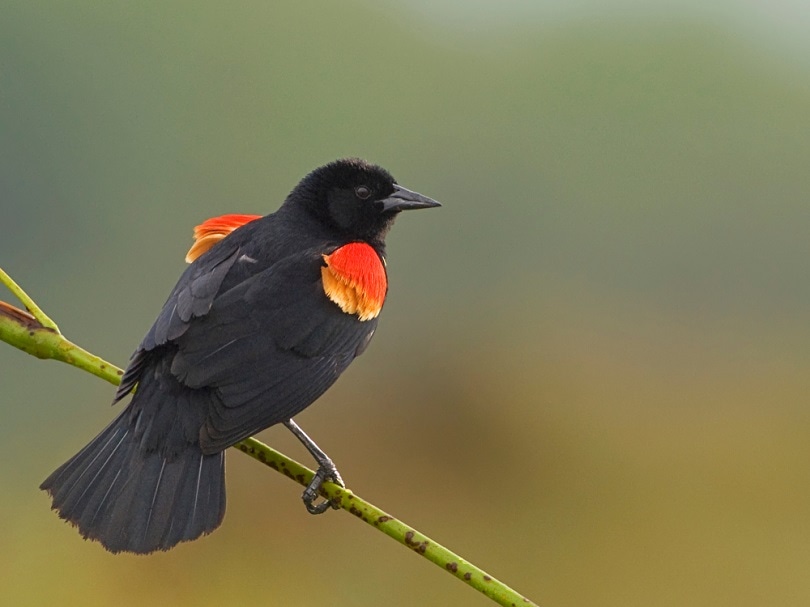
| Length: | 6.7–9.1 in |
| Weight: | 1.1–2.7 oz |
| Wingspan: | 12.2–15.8 in |
You can’t really mistake the male red-winged blackbirds for anything else. They are glossy black with red and yellow patches on their shoulders that get bigger when they spread their wings. The females aren’t quite so obvious because they actually aren’t black at all. The females are mostly a streaked dark brown color.
Male blackbirds love attention. They will perch high in a noticeable area and sing loudly while fluttering their wings to show off their red and yellow badges. During the winter, these beautiful birds will flock with other species of blackbirds and even starlings to search for food together.
18. European Starling
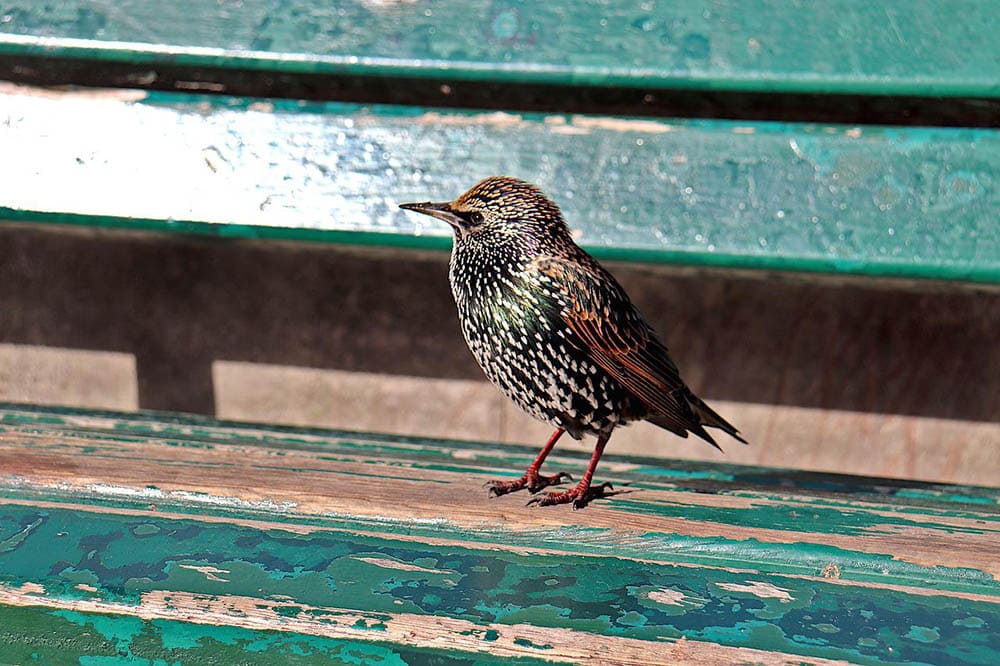
| Length: | 7.9–9.1 in |
| Weight: | 2.1–3.4 oz |
| Wingspan: | 12.2–15.8 in |
A European starling actually appears black when seen from a distance. But their colors change slightly between seasons. For example, their plumage is an iridescent purplish green during the summer. Then in the winter, they are brown with bright, white spots.
These birds quite often will flock with other species of bird-like blackbirds or grackles, and they can be quite noisy. They are commonly found where humans are. Lawns, fields, and even sidewalks or parking lots are favorite places for these birds to find a meal.
19. California Scrub-Jay
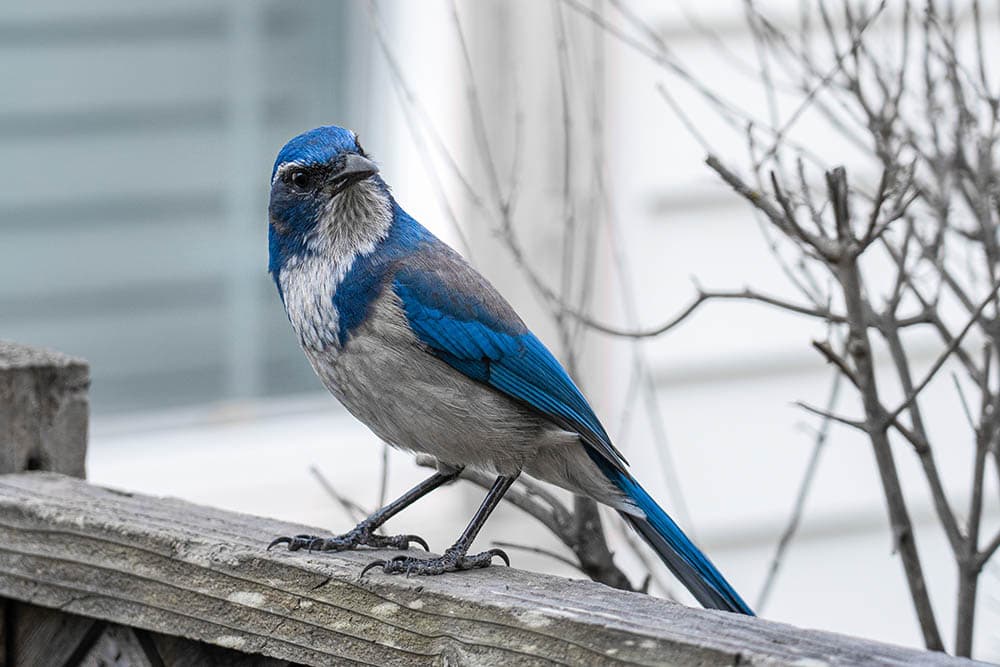
| Length: | 11-11.8 in |
| Weight: | 2.5–3.5 oz |
| Wingspan: | 15.3 in |
The California scrub-jay is an incredible-looking bird characterized by its rich azure blue and gray head and back. It also has a blue line that forms a “necklace” on its otherwise white chest and underparts.
These birds seem to prefer low and dry habitats. However, they are also commonly found in oak forests, farm pastures, and backyards. They also love to sing, so you may hear them before seeing them.
20. Spotted Towhee

| Length: | 6.7–8.3 in |
| Weight: | 1.2–1.7 oz |
| Wingspan: | 11 in |
The upper half of an adult male spotted towhee is deep black—including their beak. Their back and wings are also black, except the black is contrasted by small white patches and spots. A rusty orange flank with a white belly is also characteristic of these birds. The only difference in the female spotted towhee is that they are more of a grayish-brown instead of black.
These birds love to be on the ground, so scattering their favorite seeds is a great way to encourage them to visit your backyard. Suppose you’re going out searching for them. In that case, you’ll likely find them in overgrown forest edges among the undergrowth or tangled brush fields.
21. Yellow-Rumped Warbler
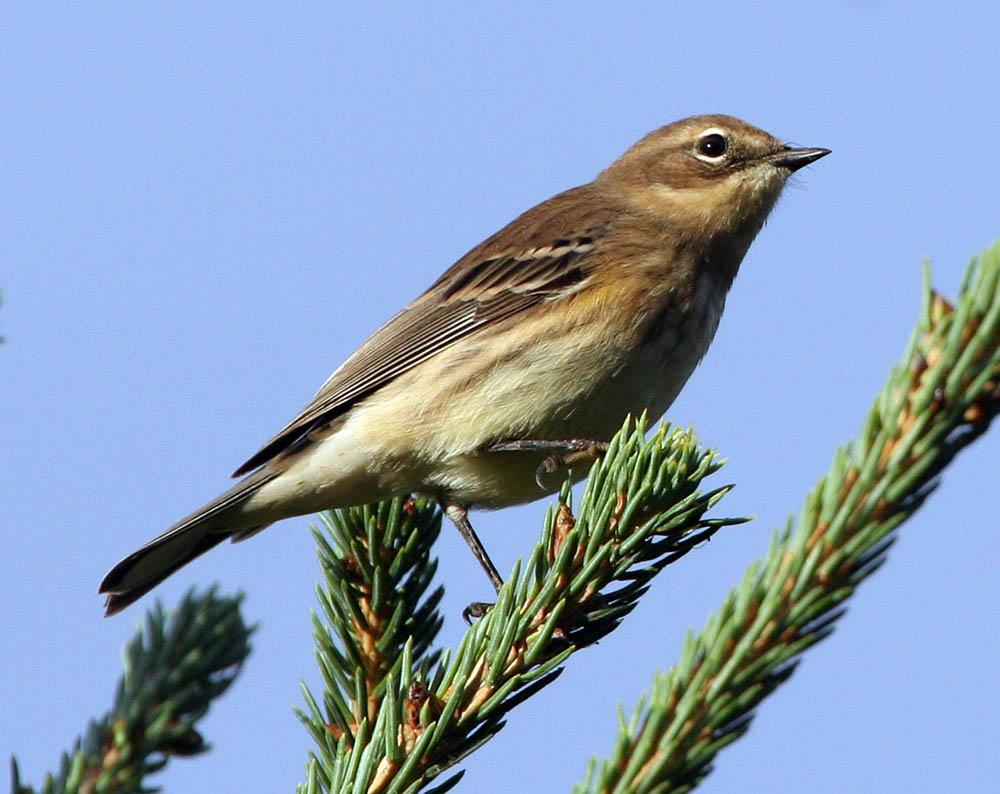
| Length: | 4.7–5.5 in |
| Weight: | 0.4–0.5 oz |
| Wingspan: | 7.5–9.1 in |
The yellow-rumped warbler is a nice mixture of gray-blue, white, and yellow during the summer. The primary color characteristic of these birds is their yellow throat, forehead, and sides. The males are typically more vibrantly shaded, whereas the females have more shades of brown and duller colors.
You’ll often see these birds snagging insects from the air or snacking on berries. They prefer coniferous forests during the summer, but these birds will move into open areas, backyards, or parks come fall and winter.
22. Northern Flicker
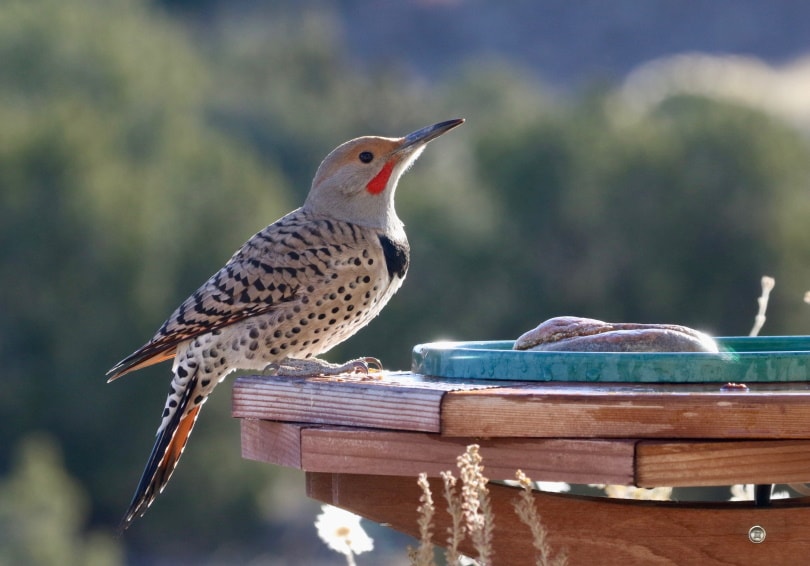
| Length: | 11–12.2 in |
| Weight: | 3.9–5.6 oz |
| Wingspan: | 16.5–20.1 in |
The northern flicker is mostly gray-brown overall. However, they have black spots that cover their brown plumage. And depending on where they’re from the underside of their wings and tail will be either red or bright yellow.
These birds spend most of their time on the ground and prefer open areas near trees, backyards, or parks. If you do see them in a tree, they will likely be perching upright on a horizontal branch.
23. Lesser Goldfinch

| Length: | 3.5–4.3 in |
| Weight: | 0.3–0.4 oz |
| Wingspan: | 5.9–7.9 in |
The lesser goldfinch is a vibrantly colored bird. Adult males have bright yellow underparts with a black head and back, and they have white patches on their wings. In some cases, their back may also have a dull green hue instead of black. Females and young males are also yellow but much paler. And their backs are more of an olive color as opposed to black.
Flocks of the lesser goldfinch can be several hundred birds. When it comes to feeding, it’s not uncommon for these birds to mix with other similar songbirds at a birdfeeder or in a field.
24. Steller’s Jay

| Length: | 11.8–13.4 in |
| Weight: | 3.5–4.9 oz |
| Wingspan: | 17.3 in |
Steller’s jays are characterized by their lack of white belly like many other species of jaybird. These birds have black heads that fade into dark blue. The blue lightens to the point of almost sparkling towards the wing tips.
These jays love to explore and aren’t scared. They spend a lot of time exploring the forest canopy, but they descend to greet forest visitors and find a snack. They have the most unique way of hopping around on their long legs when they reach the ground.
25. Verdin
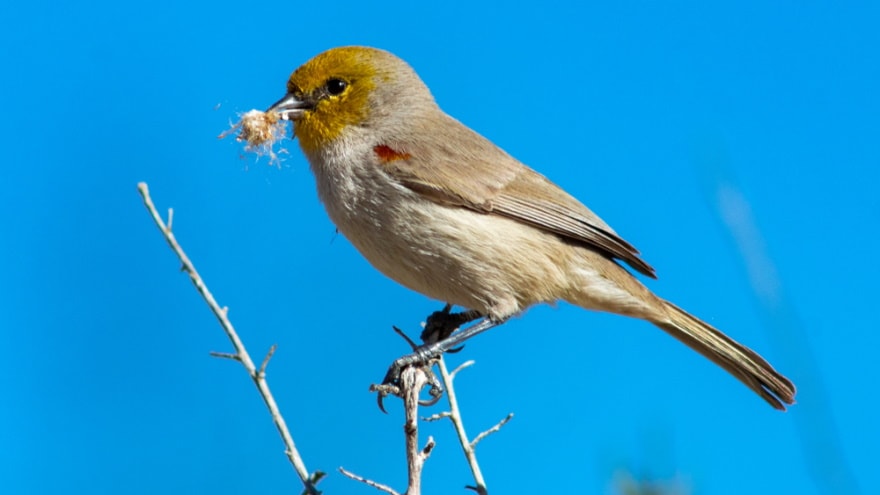
| Length: | 3.5–4.3 in |
| Weight: | 0.2–0.3 oz |
| Wingspan: | 6.2–6.7 in |
Rounding up our list of birds is the verdin. These tiny birds have unique yellow heads that contrast their gray bodies. The other standout feature they have is a chestnut brown spot at the end of their wing.
A neat thing about the verdin is that it will actually hang upside down from branches to find spiders or other insects to eat. It prefers areas with desert scrub and scattered trees. It can be coaxed into a backyard with food and nesting boxes.

Closing Thoughts
There are a lot of birds to find in Nevada. Whether you’re looking in your backyard or beyond, you won’t find them all in a day. So, grab your binoculars and a comfy pair of shoes, and get out in the parks and wooded areas around you and see what you can find.
See Also: 9 Types of Hummingbirds in Nevada (With Pictures)
Featured Image Credit: PublicDomainImages, Pixabay
About the Author Shea Cummings
Shea Cummings is a passionate content writer who believes that the power of words is immeasurable. He leverages years of experience in various trades such as carpentry, photography, and electrical to bring his articles to life. His goal is to provide his readers with information that delights and informs. When he's not writing you can find him spending time in the outdoors or playing some Minecraft on the Xbox with his wife and two sons.
Related Articles:
Monocular vs Telescope: Differences Explained (With Pictures)
10 Types of Hummingbirds in Arkansas (With Pictures)
8 Types of Hummingbirds in Nebraska (With Pictures)
5 Types of Hummingbirds in Idaho (With Pictures)
3 Types of Hummingbirds in Mississippi (With Pictures)
8 Types of Hummingbirds in Kansas (With Pictures)
5 Types of Hummingbirds in West Virginia (With Pictures)
5 Types of Hummingbirds in Ohio (With Pictures)
